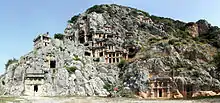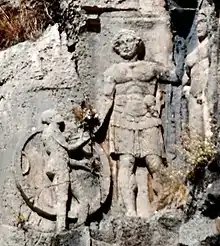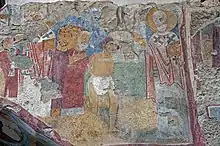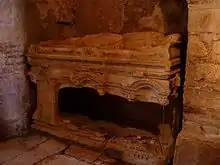Myra
Myra (Ancient Greek: Μύρα, Mýra) was an ancient Greek, then Roman Greek, then Byzantine Greek, then Ottoman Greek town in Lycia, which became the small Turkish town of Kale, renamed Demre in 2005, in the present-day Antalya Province of Turkey. In 1923 its Greek inhabitants had been required to leave by the Population exchange between Greece and Turkey, at which time its church was finally abandoned. It was founded on the river Myros (Ancient Greek: Μύρος; Turkish: Demre Çay), in the fertile alluvial plain between Alaca Dağ, the Massikytos range and the Aegean Sea.
Μύρα (in Ancient Greek) | |
 The theatre of Myra, with the rock-cut tombs of the ancient Lycian necropolis on the cliff in the background. | |
 Shown within Turkey | |
| Location | Demre, Antalya Province, Turkey |
|---|---|
| Region | Lycia |
| Coordinates | 36°15′33″N 29°59′07″E |
| Type | Settlement |
History


Although some scholars equate Myra with the town Mira in Arzawa, there is no proof for the connection. There is no substantiated written reference for Myra before it was listed as a member of the Lycian league (168 BC – AD 43); according to Strabo (14:665) it was one of the largest towns of the alliance.
The ancient Greek citizens worshiped Artemis Eleutheria, who was the protective goddess of the town. Zeus, Athena and Tyche were venerated as well. Pliny the Elder writes that in Myra there was the spring of Apollo called Curium and when summoned three times by the pipe the fishes come to give oracular responses.[1] In the Roman period Myra formed a part of the Koine Greek speaking world that rapidly embraced Christianity. One of its early Greek bishops was Saint Nicholas.
The ruins of the Lycian and Roman town are mostly covered by alluvial silts. The Acropolis on the Demre-plateau, the Roman theatre and the Roman baths (eski hamam) have been partly excavated. The semi-circular theater was destroyed in an earthquake in 141, but rebuilt afterwards.
There are two necropoleis of Lycian rock-cut tombs in the form of temple fronts carved into the vertical faces of cliffs at Myra: the river necropolis and the ocean necropolis. The ocean necropolis is just northwest of the theater. The best-known tomb in the river necropolis, 1.5 km (0.93 mi) up the Demre Cayi from the theater, is the "Lion's tomb", also called the "Painted Tomb". When the traveller Charles Fellows saw the tombs in 1840 he found them still colorfully painted red, yellow and blue.

Andriake was the harbour of Myra in classical times, but silted up later on. The main structure there surviving to the present day is a granary (horrea) built during the reign of the Roman emperor Hadrian (117–138 AD). Beside this granary is a large heap of Murex shells, evidence that Andriake had an ongoing operation for the production of purple dye.[3]
Excavations have been carried out at Andriake since 2009. The granary was turned into the Museum of Lycian Civilizations. The granary has seven rooms and measures 56 meters long and 32 meters wide. Artifacts found during the excavations in the Lycian League were placed in the museum. The structures in the Harbor market as well as the agora, synagogue and a six-meter deep, 24-meter long and 12-meter wide cistern were restored. A 16-meter long Roman-era boat, a crane and a cargo car were placed in front of the museum.[4]
New Testament
The author of the Acts of the Apostles (probably Luke the Evangelist)[5][6] and Paul the Apostle changed ships here during their journey from Caesarea to Rome for Paul's trial, arriving in a coastal trading vessel and changing to a sea-faring skiff secured by the Roman centurion responsible for Paul's transportation to Rome.[7]
Bishopric



The Acta Pauli probably testify to the existence of a Christian community at Myra in the 2nd century.[8] Le Quien opens his list of the bishops of this city with St. Nicander, martyred under Domitian in 95, who, according to the Greek Menologion, was ordained bishop by Saint Titus. In 325, Lycia again became a Roman province distinct from that of Pamphylia, with Myra as its capital. Ecclesiastically, it thus became the metropolitan see of the province. The bishop of Myra at that time was Saint Nicholas. The 6th-century Index of Theodorus Lector is the first document that lists him among the fathers of the First Council of Nicaea in 325.[9] Many other bishops of Myra are named in extant documents, including Petrus, the author of theological works in defence of the Council of Chalcedon quoted by Saint Sophronius of Jerusalem and by Photius (Bibliotheca, Codex 23). Theodorus and Nicolaus were both at the Second Council of Nicaea in 787, the former recanting his previous iconoclast position, the latter being the Catholic bishop whom the iconoclasts had expelled. The Notitia Episcopatuum of Pseudo-Epiphanius, composed in about 640 under the Byzantine Emperor Heraclius, reports that Myra at that time had 36 suffragan sees. The early 10th-century Notitia attributed to Emperor Leo VI the Wise lists only 33.[10][11][12]
Myra is today listed by the Catholic Church as a titular see both in general and as a bishopric of the Melkite Catholic Church in particular. While Latin bishops are no longer appointed to this Eastern titular see, Melkite bishops are.[13]
Siege of 809

After a siege in 809, Myra fell to Abbasid troops under Caliph Harun al-Rashid. Early in the reign of Alexius I Comnenus (ruled between 1081 and 1118), Myra was again overtaken by Islamic invaders, this time the Seljuk Turks. In the confusion, sailors from Bari in Italy seized the relics of Saint Nicholas, over the objections of the monks caring for them, and spirited the remains away to Bari, where they arrived on May 9, 1087, and soon brought that city visitors making pilgrimage to Saint Nicholas.
Church of St. Nicholas at Myra

The earliest church of St. Nicholas at Myra was built by the Eastern Roman (Byzantine) Empire in the 6th century. The present-day church was constructed mainly from the 8th century onward for the city's Byzantine Greek inhabitants; a Greek Orthodox monastery was added in the second half of the 11th century.
In 1863, Emperor Alexander II of Russia purchased the building and began restoration, but the work was never completed. In 1923 the church was abandoned when the city's Christian inhabitants were forced to leave for Greece by the Population exchange between Greece and Turkey. In 1963 the eastern and southern sides of the church were excavated. In 1968 the former confessio (tomb) of St. Nicholas was roofed over.
The floor of the church is made of opus sectile, a mosaic of coloured marble, and there are some remains of frescoes on the walls. An ancient Greek marble sarcophagus had been reused to bury the Saint; but his bones were stolen in 1087 by merchants from Bari, and are now held in that city, in the Basilica of Saint Nicholas.
The church is currently undergoing restoration. In 2007 the Turkish Ministry of Culture gave permission for the Divine Liturgy to be celebrated in the church for the first time in centuries. On 6 December 2011 Metropolitan Chrysostomos, who has the title of Myra, accordingly officiated.[14]
Archaeology

Archaeologists first detected the ancient city in 2009 using ground-penetrating radar that revealed anomalies whose shape and size suggested walls and buildings. Over the next two years they excavated a small, stunning 13th-century chapel sealed in an uncanny state of preservation. Carved out of one wall is a cross that, when sunlit, beams its shape onto the altar.[15] In February 2021, Akdeniz University researchers led by Nevzat Çevik announced the discovery of dozens of 2,200-year-old terracotta sculptures with inscriptions. Archaeologists also revealed some material remains of the Hellenistic theater made of ceramic, bronze, lead, and silver. The figurines with partly preserved paint contained the appearances of men, women, cavalry, animals, some Greek deities and the names of artists.[16][17][18]
Notable people
- Saint Nicholas, bishop of Myra.
- Saint Themistocles, a Christian martyr. [19][20]
- Dioskorios (Ancient Greek: Διοσκόριος) of Myra, a grammarian and prefect of the city. He was tutor of the daughters of the emperor Leon. Brother of Nicolaus of Myra.[21][22]
- Nicolaus (Ancient Greek: Νικόλαος) of Myra, a rhetor and sophist who wrote an Art of Rhetoric and declamations, pupil of Lachares. Brother of Dioskorios of Myra.[23]
See also
References
- Pliny the Elder, Natural History, §32.8.1
- Fant, Clyde E.; Reddish, Mitchell G. (2003). A Guide to Biblical Sites in Greece and Turkey. Oxford University Press. p. 485. ISBN 9780199881451.
- Gerhard Forstenpointer, et al., "Purple-Dye Production in Lycia – Results of an Archaeozoological Field Survey in Andriake (South-west Turkey)." Oxford Journal of Archaeology 26, 2 (2007):201–214.
- Andriake opens partially to visits
- Charlesworth 2008, p. no page numbers.
- Burkett 2002, p. 195.
- Acts 27:5–6
- Harnack, Mission und Ausbreitung des Christentums, 465, 487 (cited by Salaviel)
- Heinrich Gelzer, Patrum Nicaenorum nomina, 67, n. 161 (cited by Salaviel)
- Le Quien, Michel (1740). Oriens Christianus, in quatuor Patriarchatus digestus: quo exhibentur ecclesiæ, patriarchæ, cæterique præsules totius Orientis. Tomus primus: tres magnas complectens diœceses Ponti, Asiæ & Thraciæ, Patriarchatui Constantinopolitano subjectas (in Latin). Paris: Ex Typographia Regia. cols. 965–970. OCLC 955922585.
- Sévérien Salaville, v. "Myra" in Catholic Encyclopedia, vol. X, New York 1911
- Pius Bonifacius Gams, Series episcoporum Ecclesiae Catholicae, Leipzig 1931, p. 449
- Annuario Pontificio 2013 (Libreria Editrice Vaticana 2013 ISBN 978-88-209-9070-1), p. 931
- romfea.gr
- Sealed Under Turkish Mud, a Well-Preserved Byzantine Chapel
- "Painted Terracotta Figurines Discovered in Turkey - Archaeology Magazine". www.archaeology.org. Retrieved 2021-02-09.
- February 2021, Yasemin Saplakoglu-Staff Writer 04. "Greek gods and ancient mortals 'resurrected' in terracotta figurines discovered in Turkey". livescience.com. Retrieved 2021-02-09.
- "Figurines found in Myra ancient city". Hürriyet Daily News. Retrieved 2021-02-09.
- Martyr Themistocles of Myra in Lycia
- Themistocles the Martyr of Myra
- Suda Encyclopedia, th.530
- Suda Encyclopedia, § del.1208
- Suda Encyclopedia, §nu.395
Bibliography
- Burkett, Delbert (2002). An Introduction to the New Testament and the Origins of Christianity. Cambridge University Press. ISBN 978-0-521-00720-7.CS1 maint: ref=harv (link)
- Charlesworth, James H. (2008). The Historical Jesus: An Essential Guide. Abingdon Press. ISBN 978-1-4267-2475-6.CS1 maint: ref=harv (link)
External links
| Wikimedia Commons has media related to Myra. |
- Sites in Myra
- Numismatic Links
- Demre Guide
- Finally a mass in the church of Saint Nicholas in Myra article from AsiaNews.it
Photos and videos
- QTVR fullscreen panoramas of the Church of St. Nicholas and the Roman theatre
- Myra Guide and Photo Album
- Demre Guide and Photo Album
- Virtual tour of the ancient city
- Livius.org: Myra
- 70 pictures of the classical city, with link to 130 pictures of Saint Nicholas church